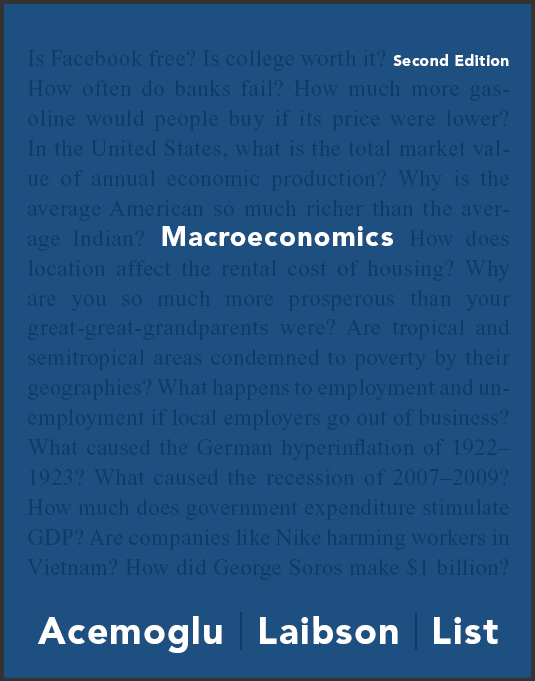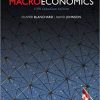Solution manual For Macroeconomics 2nd Edition Daron Acemoglu, David Laibson, John List ISBN 0134461908 9780134461908
$70.00 Original price was: $70.00.$35.00Current price is: $35.00.
Instant download (Solution manual) Macroeconomics 2nd Edition Daron Acemoglu after payment
Solution manual For Macroeconomics 2nd Edition Daron Acemoglu, David Laibson, John – Ebook PDF Instant Download/Delivery: 0134461908, 9780134461908
Full dowload Macroeconomics 2nd Edition after payment

Product details:
ISBN 10: 0134461908
ISBN 13: 9780134461908
Author: Daron Acemoglu, David Laibson, John List
Macroeconomics 2nd Table of contents:
Part I Introduction to Economics
1 The Principles and Practice of Economics
Chapter Outline
Key Ideas
1.1 The Scope of Economics
Economic Agents and Economic Resources
Definition of Economics
Positive Economics and Normative Economics
Positive Economics Describes What People Actually Do
Normative Economics Recommends What People Ought to Do
Normative Analysis and Public Policy
Microeconomics and Macroeconomics
1.2 Three Principles of Economics
1.3 The First Principle of Economics: Optimization
Trade-offs and Budget Constraints
Opportunity Cost
Assigning a Monetary Value to an Opportunity Cost
Cost-Benefit Analysis
1.4 The Second Principle of Economics: Equilibrium
The Free-Rider Problem
1.5 The Third Principle of Economics: Empiricism
1.6 Is Economics Good for You?
Summary
Key Terms
Questions
Problems
2 Economic Methods and Economic Questions
Chapter Outline
Key Ideas
2.1 The Scientific Method
Models and Data
An Economic Model
Means and Medians
Argument by Anecdote
2.2 Causation and Correlation
The Red Ad Blues
Causation versus Correlation
When Correlation Does not Imply Causality
Experimental Economics and Natural Experiments
2.3 Economic Questions and Answers
Summary
Key Terms
Questions
Problems
Appendix Constructing and Interpreting Charts and Graphs
A Study about Incentives
Experimental Design
Describing Variables
Pie Charts
Bar Charts
Time Series Graphs
Cause and Effect
Correlation Does not Necessarily Imply Causality
Appendix Key Terms
Appendix Problems
3 Optimization: Doing the Best You Can
Chapter Outline
Key Ideas
3.1 Optimization: Choosing the Best Feasible Option
3.2 Optimization Application: Renting the Optimal Apartment
Before and After Comparisons
3.3 Optimization Using Marginal Analysis
Marginal Cost
Summary
Key Terms
Questions
Problems
4 Demand, Supply, and Equilibrium
Chapter Outline
Key Ideas
4.1 Markets
Competitive Markets
4.2 How Do Buyers Behave?
Demand Curves
Willingness to Pay
From Individual Demand Curves to Aggregated Demand Curves
Building the Market Demand Curve
Shifting the Demand Curve
Changes in Tastes and Preferences
Changes in Income and Wealth
Changes in Availability and Prices of Related Goods
Changes in Number and Scale of Buyers
Changes in Buyers’ Beliefs about the Future
4.3 How Do Sellers Behave?
Supply Curves
Willingness to Accept
From the Individual Supply Curve to the Market Supply Curve
Shifting the Supply Curve
Changes in Prices of Inputs Used to Produce the Good
Changes in Technology Used to Produce the Good
Changes in the Number and Scale of Sellers
Changes in Sellers’ Beliefs about the Future
4.4 Supply and Demand in Equilibrium
Curve Shifting in Competitive Equilibrium
4.5 What Would Happen If the Government Tried to Dictate the Price of Gasoline?
Summary
Key Terms
Questions
Problems
Part II Introduction to Macroeconomics
5 The Wealth of Nations: Defining and Measuring Macroeconomic Aggregates
Chapter Outline
Key Ideas
5.1 Macroeconomic Questions
5.2 National Income Accounts: Production = Expenditure = Income
Production
Expenditure
Income
Circular Flows
National Income Accounts: Production
National Income Accounts: Expenditure
National Income Accounting: Income
5.3 What Isn’t Measured by GDP?
Physical Capital Depreciation
Home Production
The Underground Economy
Negative Externalities
Gross Domestic Product versus Gross National Product
The Increase in Income Inequality
Leisure
Does GDP Buy Happiness?
5.4 Real versus Nominal
The GDP Deflator
The Consumer Price Index
Inflation
Adjusting Nominal Variables
Summary
Key Terms
Questions
Problems
6 Aggregate Incomes
Chapter Outline
Key Ideas
6.1 Inequality Around the World
Measuring Differences in GDP per Capita
Inequality in GDP per capita
GDP per Worker
Productivity
Incomes and the Standard of Living
6.2 Productivity and the Aggregate Production Function
Productivity Differences
The Aggregate Production Function
Labor
Physical Capital and Land
Technology
Representing the Aggregate Production Function
6.3 The Role and Determinants of Technology
Technology
Dimensions of Technology
Entrepreneurship
Summary
Key Terms
Questions
Problems
Appendix The Mathematics of Aggregate Production Functions
Part III Long-Run Growth and Development
7 Economic Growth
Chapter Outline
Key Ideas
7.1 The Power of Economic Growth
A First Look at U.S. Growth
Exponential Growth
Patterns of Growth
7.2 How Does a Nation’s Economy Grow?
Optimization: The Choice Between Saving and Consumption
What Brings Sustained Growth?
Knowledge, Technological Change, and Growth
7.3 The History of Growth and Technology
Growth Before Modern Times
Malthusian Limits to Growth
The Industrial Revolution
Growth and Technology Since the Industrial Revolution
7.4 Growth, Inequality, and Poverty
Growth and Inequality
Growth and Poverty
How Can We Reduce Poverty?
Summary
Key Terms
Questions
Problems
Appendix The Solow Growth Model
The Three Building Blocks of the Solow Model
Steady-State Equilibrium in the Solow Model
Determinants of GDP
Dynamic Equilibrium in the Solow Model
Sources of Growth in the Solow Model
Calculating Average (Compound) Growth Rates
Appendix Key Terms
Appendix Problems
8 Why Isn’t the Whole World Developed?
Chapter Outline
Key Ideas
8.1 Proximate Versus Fundamental Causes of Prosperity
Geography
Culture
Institutions
A Natural Experiment of History
8.2 Institutions and Economic Development
Inclusive and Extractive Economic Institutions
How Economic Institutions Affect Economic Outcomes
The Logic of Extractive Economic Institutions
Inclusive Economic Institutions and the Industrial Revolution
8.3 Is Foreign Aid the Solution to World Poverty?
Summary
Key Terms
Questions
Problems
Part IV Equilibrium in the Macroeconomy
9 Employment and Unemployment
Chapter Outline
Key Ideas
9.1 Measuring Employment and Unemployment
Classifying Potential Workers
Calculating the Unemployment Rate
Trends in the Unemployment Rate
9.2 Equilibrium in the Labor Market
The Demand for Labor
Shifts in the Labor Demand Curve
The Supply of Labor
Shifts in the Labor Supply Curve
Equilibrium in a Competitive Labor Market
9.3 Why Is There Unemployment?
Voluntary Unemployment
Job Search and Frictional Unemployment
9.4 Wage Rigidity and Structural Unemployment
Minimum Wage Laws
Labor Unions and Collective Bargaining
Efficiency Wages
Downward Wage Rigidity
9.5 Cyclical Unemployment and the Natural Rate of Unemployment
Summary
Key Terms
Questions
Problems
10 Credit Markets
Chapter Outline
Key Ideas
10.1 What Is the Credit Market?
Borrowers and the Demand for Loans
Real and Nominal Interest Rates
The Credit Demand Curve
Saving Decisions
The Credit Supply Curve
Equilibrium in the Credit Market
Credit Markets and the Efficient Allocation of Resources
10.2 Banks and Financial Intermediation: Putting Supply and Demand Together
Assets and Liabilities on the Balance Sheet of a Bank
Assets
Liabilities and Stockholders’ Equity
10.3 What Banks Do
Identifying Profitable Lending Opportunities
Maturity Transformation
Management of Risk
Bank Runs
Bank Regulation and Bank Solvency
Summary
Key Terms
Questions
Problems
11 The Monetary System
Chapter Outline
Key Ideas
11.1 Money
The Functions of Money
Types of Money
The Money Supply
11.2 Money, Prices, and GDP
Nominal GDP, Real GDP, and Inflation
The Quantity Theory of Money
11.3 Inflation
What Causes Inflation?
The Consequences of Inflation
The Social Costs of Inflation
The Social Benefits of Inflation
11.4 The Federal Reserve
The Central Bank and the Objectives of Monetary Policy
What Does the Central Bank Do?
Regulation
Interbank Transfers
Management of Macroeconomic Fluctuations by Manipulating the Quantity of Bank Reserves
11.5 Bank Reserves and the Plumbing of the Monetary System
Bank Reserves and Liquidity
The Demand Side of the Federal Funds Market
The Supply Side of the Federal Funds Market and Equilibrium in the Federal Funds Market
Summary of the Fed’s Control of the Federal Funds Rate
The Fed’s Influence on the Money Supply and the Inflation Rate
Summary of the Fed’s Influence on the Money Supply and the Inflation Rate
The Relationship Between the Federal Funds Rate and the Long-Term Real Interest Rate
Summary of the Fed’s Influence on Long-Term Expected Real Interest Rates
Summary
Key Terms
Questions
Problems
Part V Short-Run Fluctuations and Macroeconomic Policy
12 Short-Run Fluctuations
Chapter Outline
Key Ideas
12.1 Economic Fluctuations and Business Cycles
Patterns of Economic Fluctuations
Co-Movement
Limited Predictability of Turning Points
Persistence in the Rate of Economic Growth
The Great Depression
12.2 Macroeconomic Equilibrium and Economic Fluctuations
Labor Demand and Fluctuations
Sources of Fluctuations
1. Technology Shocks: Explanations from Real Business Cycle Theory
2. Sentiments and Multipliers: Explanations from John Maynard Keynes
3. Monetary and Financial Factors: Explanations from Milton Friedman
Multipliers and Economic Fluctuations
Equilibrium in the Medium Run: Partial Recovery and Full Recovery
12.3 Modeling Expansions
Summary
Key Terms
Questions
Problems
13 Countercyclical Macroeconomic Policy
Chapter Outline
Key Ideas
13.1 The Role of Countercyclical Policies in Economic Fluctuations
13.2 Countercyclical Monetary Policy
Controlling the Federal Funds Rate
Other Tools of the Fed
Expectations, Inflation, and Monetary Policy
Contractionary Monetary Policy: Control of Inflation
Zero Lower Bound
Policy Trade-offs
13.3 Countercyclical Fiscal Policy
Fiscal Policy Over the Business Cycle: Automatic and Discretionary Components
Analysis of Expenditure-Based Fiscal Policy
Crowding Out
Analysis of Taxation-Based Fiscal Policy
Fiscal Policies That Directly Target the Labor Market
Policy Waste and Policy Lags
Summary
Key Terms
Questions
Problems
Part VI Macroeconomics in a Global Economy
14 Macroeconomics and International Trade
Chapter Outline
Key Ideas
14.1 Why and How We Trade
Absolute Advantage and Comparative Advantage
Comparative Advantage and International Trade
Efficiency and Winners and Losers from Trade
How We Trade
Trade Barriers: Tariffs
14.2 The Current Account and the Financial Account
Trade Surpluses and Trade Deficits
International Financial Flows
Income-Based Payments from Foreigners
Income-Based Payments to Foreigners
The Workings of the Current Account and the Financial Account
14.3 International Trade, Technology Transfer, and Economic Growth
Summary
Key Terms
Questions
Problems
15 Open Economy Macroeconomics
Chapter Outline
Key Ideas
15.1 Exchange Rates
Nominal Exchange Rates
Flexible, Managed, and Fixed Exchange Rates
15.2 The Foreign Exchange Market
How Do Governments Intervene in the Foreign Exchange Market?
Defending an Overvalued Exchange Rate
15.3 The Real Exchange Rate and Exports
From the Nominal to the Real Exchange Rate
Co-Movement Between the Nominal and the Real Exchange Rates
The Real Exchange Rate and Net Exports
15.4 GDP in the Open Economy
Revisiting Black Wednesday
Interest Rates, Exchange Rates, and Net Exports
People also search for Macroeconomics 2nd:
understanding macroeconomics 2nd edition
understanding macroeconomics 2nd edition pdf
mishkin macroeconomics 2nd edition
macroeconomics 2nd semester pdf notes


